Neurochemistry II – Flashcards
Unlock all answers in this set
Unlock answersquestion
Agonist
answer
Any ligand (including NT's) that binds to a receptor and produces a physiological effect. Can be Partial or Inverse
question
Partial Agonist
answer
Binds to the same site as a Full Agonist but has a lower physiological efficacy at an equimolar concentration of the Full Agonist
question
Inverse Agonist
answer
Has an action opposite that of the Agonist
question
Antagonist
answer
Blockers of the actions of the Agonist Competitive and Non-Competitive
question
Competitive Antagonist
answer
Binds to the agonist's binding site and can displace the agonist but has NO PHYSIOLOGICAL EFFECTS.
question
Non-Competitive Antagonist
answer
Blocks the actions of the agonist, but does so at a site other than the Agonist's binding site. Does not include Ion Channel blockers, as they do not bind to any receptor, but simply lodge in the channel
question
Allosteric Modulators
answer
Substances that act at regulatory sites somewhere on the receptor different from that of the Endogenous ligand. Their effects can be enhancing or inhibiting when compared to the Endogenous Ligand or other Agonists, and they typically function by causing conformational changes in the bound molecule.
question
Benzodiazepine (BZD)
answer
Allosteric Modulator that binds to the GABA(a) receptor and enhances the channels conductance whenever GABA molecules actually become bound to their sites
question
Choline Acetyltransferase (ChAT)
answer
Catalyzes the synthesis of Acetylcholine: AcetylCoA + Choline --> Acetylcholine
question
Acetylcholinesterase (AChE)
answer
ACh is taken back up after exerting its effect, so it must be degraded by AChE: Acetylcholine --> Acetate + Choline
question
Organophosphates
answer
Irreversible Cholinesterase inhibitors effective in very low concentrations, giving them some applications: Insecticides - Toxic to target but not animals and humans Nerve Poisons (Sarin, VS)
question
Effects of Cholinergic Stimulation and Antidote
answer
EFFECTS: Vasodilation, Slower Heart Rate, Constriction of Bronchioles, Reduced Mucus Secretion in Respiratory Tract, Intestinal Cramps, Secretion of Saliva, Sweat and Tears, Miosis, Convulsions, Asphyxia and Death ANTIDOTE: Cholinergic Synaptic Blockers (Atropine)
question
Pralidoxime (2-PAM)
answer
Directly acting antidote that couples to the bound toxin and facilitates hydrolysis of the bond at the esoteric site Serine residue on AChE.
question
Biosynthesis of ACh
answer
AcetylCoA is readily available in Axon Terminal. Choline is taken up by transporters in Synaptic Areas (it is a degradation produce from AChE hydrolysis) ChAT produces ACh which is then taken up by vesicles.
question
Nicotinic Receptor - Agonist, Antagonist, Type & Action
answer
AGONIST: Nicotine ANTAGONIST: Curare RECEPTOR TYPE: Ligand-Gated Ion Channel RECEPTOR ACTION: fEPSP Found at NMJ
question
Myasthenia Gravis
answer
Autoimmune disease against Nicotinic Receptors at the NMJ
question
Muscarinic Receptor - Agonist, Antagonist, Type & Action
answer
AGONIST: Muscarine ANTAGONIST: Atropine RECEPTOR TYPE: G-Protein Coupled (Gi, Gp) RECEPTOR ACTION: Can be sEPSP, or sIPSP Predominant Cholinergic Receptor in the CNS
question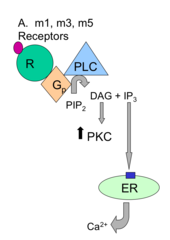
m1, m3, m5 Muscarinic Receptors

answer
↑ Phosophlipase C Activity via Gp: PIP₂ → DAG + IP₃ ↑DAG = ↑PKC ↑IP₃ = ↑ Ca²⁺ release from ER These receptors are associated with EPSPs!
question
m2, m4 Muscaranic Receptors (Brain vs. Heart)
answer
BRAIN: ↓ Adenylate Cyclase via Gi: ↓ Adenylate Cyclase = ↓ cAMP HEART - Two different effects combine to reduce Heart Rate: BETA/GAMMA SUBUNITS: Open K⁺ channels, causing a hyperpolarizing effect. Gi/ALPHA SUBUNIT: Decreases Adenylate Cyclase, which reduces cAMP production and PKA function, acting to decrease conductance of Ca²⁺ channels *In the Heart, it is the m2 channel only that is functioning* m2,m4 channels are associated with IPSP's!
question
Catecholamine Structural Differences
answer
Have the general structure: Catechol - CH(R1)-CH₂-NH₂(R2) DOPAMINE: R1 & R2 = H NOREPINEPHRINE: R1 = OH, R2 = H EPINEPHRINE: R1 = OH, R2 = CH₃
question
Indoleamine Structures
answer
Indole-CH₂-CH₂-NH₂(R1) SEROTONIN: R1 = H with a 5-H on the Phenyl Ring ???
question
Mapping Pathways of Brain
answer
Formaldehyde + Catecholamine = Green Fluorescence Formaldehyde + Serotonin = Yellow Fluorescence
question
Enzymes of Catecholamine Synthesis
answer
1. Tyrosine Hydroxylase 2. DOPA Decarboxylase 3. DOPA β-Hydroxylase 4. Phenylethanolamine-N-methyltransferase
question
Tyrosine Hydroxylase
answer
Cytoplasmic enzyme that catalyzes the RATE-LIMITING STEP: Tyrosine + O₂ → 1-DOPA REQUIRES: O₂, Fe²⁺ and a Pteridine Cofactor REGULATION: End Product Inhibition, Ca²⁺, Phosphorylation in response to cAMP
question
DOPA Decarboxylase (1-Aromatic Amino Acid Decarboxylase)
answer
1-DOPA → Dopamine + CO₂ Alternative name for the enzyme is because it can accept a variety of substrates; also functions in Serotonin synthesis
question
1-DOPA
answer
When given with a PERIPHERAL DOPA DECARBOXYLASE INHIBITOR it is a therapy for Parkinson's
question
DOPA β-Hydroxylase
answer
Dopamine + O₂ --> Norepinephrine Enzyme contains Cu²⁺ and is found in Synpatic Granules
question
Phenylethanolamine-N-Methyltransferase
answer
Cytoplasmic enzyme that catayzles the reaction: Norepinephrine + S-Adenosylmethionine → Epinephrine
question
Location of Catecholamine Synthesis
answer
Adrenal Medulla
question
Inactivation of Catecholamines
answer
Following action, they are taken back up via specific transporters into the Presynaptic or Postsynaptic Neurons. They can then either be packaged into vesicles and protected from degradation, or degraded.
question
Monoamine Oxidase (MAO)
answer
Catalyzes first step in Catecholamine Degredation. Two isoforms: MAO-A and MAO-B.
question
MAO-A vs. MAO-B
answer
A: Can degrade all three types of Catecholamines, but mainly E and NE B: Can degrade Dopamine
question
Main Points of Catecholamine Degradation
answer
The degradation of all three Catecholamines is similar in that it is a three step process catalyzed first by MAO, then an Aldehyde Reductase/Dehydrogenase, and finally, COMT.
question
Catechol-O-Methyltransferase (COMT)
answer
Requires Mg²⁺; catalyzes many reactions: It can degrade the intermediate products of Catecholamine Degradation AS WELL AS the beginning substrates (Dopamine, Epinephrine, Norepinephrine)
question
Which Breakdown Products Can be Tested for in the Lab?
answer
The final breakdown products for NE and E are Methoxyhydroxyphenylglycol (MHPG) and Vanillylmandelic Acid (VMA). The final breakdown product for Dopamine is Homovanillic Acid (HVA). These breakdown products can be tested for in the lab.
question
Catecholamine Pharmacology
answer
Excess Catecholamine = Behavioral Excitation; as a result, agents that elevate Catecholamines are useful in treatment of depression. Lack of Catecholamine = Depression; blocking Catecholamine function is used to treat Schizophrenia
question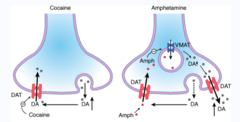
Dopamine and Cocaine

answer
Having similar structures, Cocaine is able to block the Dopamine transporter (DAT) on the Pre-synaptic Terminal, resulting in the accumulation of Dopamine in the synapse over time. The elevated Dopamine may be degraded by COMT, depending on the Brain Area
question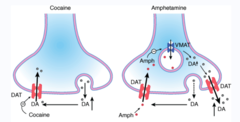
Dopamine and Amphetamines

answer
Having similar structures, Amphetamines including METH and MDMA are able to enter Pre-synpatic Neurons and reverse the functioning of Dopamine Transporters. Dopamine in vesicles is released into the cytoplasm and cytoplasmic Dopamine is then pumped into the synapse. If MDMA is taken with a MAO inhibitor, the resulting Sympathetic effects can be lethal
question
Enzymes of Serotonin Synthesis
answer
1. Tryptophan Hydroxylase 2. 5-Hydroxytryptophan Decarboxylase
question
Tryptophan Hydroxylase
answer
Tryptophan + O₂ → 5-Hydroxytryptophan
question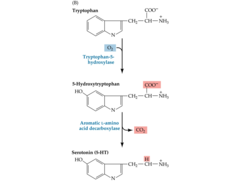
5-Hydroxytryptophan Decarboxylase (1-Aromatic Amino Acid Decarboxylase)

answer
5-Hydroxytryptophan → Serotonin + CO₂ Requires Pyridoxal Phosphate Same enzyme used in Catecholamine Synthesis
question
Degredation of Serotonin
answer
Broken down by MAO-A into 5-HIAA which is excreted into urine
question
Functions of Serotonin
answer
Regulation of Sleep and Wakefulness, Pain and Antinoceceptive Spinal Pathways
question
Selective Serotonin Reuptake Inhibitiors (SSRI's)
answer
Antidepressants
question
Glutamic Acid Decarboxylase
answer
Glutamate → GABA
question
GABA Degredation
answer
GABA → Succinic Semi-Aldehyde → Succinic Acid
question
GABA-T (GABA Transaminase)
answer
Two Reactions: α-Ketoglutarate → Glutamate GABA → Succinic Semi-Aldehyde
question
Succinic Semialdehyde Dehydrogenase (SSADH)
answer
Succinic Semi-Aldehyde → Succinic Acid
question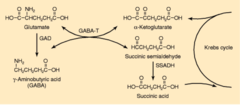
The GABA Shunt

answer
To produce GABA, you must pull α-Ketoglutarate out of the TCA cycle and not give it back until Succinic Acid is formed. The loss is 1 ATP (25% energy reduction for neurons): Kreb's Cycle = 3 ATP (from NADH) + 1 GTP (ATP) GABA Shunt = 3 ATP
question
GABA(a) Receptors
answer
Fast Ionotropic Receptors that open Cl⁻ Channels causing Hyperpolarization of the cell Barbituates (Ethanol), Benzodiazepines, Steroids and Picrotoxins can also bind here
question
GABA(b) Receptors
answer
Metabotropic Receptors connected to K⁺ channels through G proteins
question
GABA(c)
answer
Slow Ionotropic Receptors that open Cl⁻ channels (Hyperpolarization) but have an insensitivity to some antagonists and regulators that affect the A subtype
question
Serine Hydroxymethyltransferase
answer
Serine + THF → Glycine + N5-N10-Methylene THF + H₂O Produces Glycine, therefore, Glycine is not essential.
question
Bicuculline
answer
Blocks GABA(a) receptors
question
Strychnine
answer
Blocks Glycine Receptors
question
Location and Function of Glycine Receptors
answer
LOCATION: Presynaptic Nerve Endings (Renshaw Cells, a type of Interneuron?) within the Spinal Cord FUNCTION: Released in response to high Ca²⁺, it opens ligand-gated Cl⁻ channels (Hyperpolarizing, IPSP)
question
Glutamate and Receptor Types
answer
Glutamate is an excitatory Amino Acid NT in the CNS RECEPTOR SUBTYPES: Ionotropic: AMPA, Kainate, NMDA Metabotropic: mGluR1 - mGluR5
question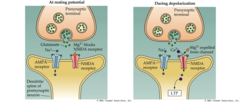
NMDA Receptor

answer
Ionotropic Receptor activated by Glutamate that allows flows of Ca²⁺ as well as Na⁺ and K⁺ At resting potential, the voltage gradient pulls Mg²⁺ into the pore, occluding ion flow .If Glutamate is released at this point, it can bind to the receptor but will have no effect. Following Depolarizations, Mg²⁺ is ejected and the pore is opened. The receptor is also subject to regulation by Glycine, just FYI...........................................
question
AMPA/Kainic Receptors
answer
Ionotropic Receptors activated by Glutamate that function in Na⁺/K⁺ conductance
question
Long-Term Potentiation
answer
A synaptic mechanism involved in memory formation and associative learning which has been best characterized in the Hippocampus. Intracellular Ca²⁺ increases via NMDA receptors, leading to increased action by CaMK. The end result in increased numbers of AMPA receptors in the Postsynaptic Membrane and Activation of Transcription FActors such as CREB that modify synaptic structure. The end result is increased synaptic strength, meaning that the same Action Potential can produce greater EPSPs.



